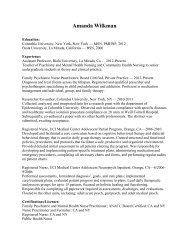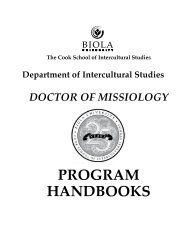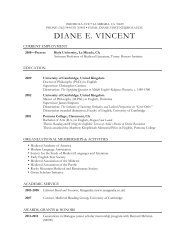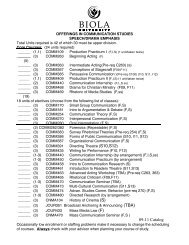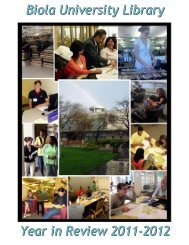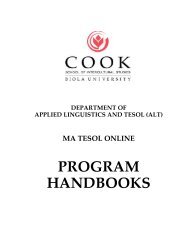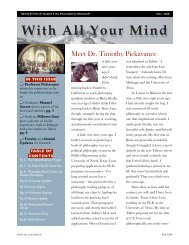PROGRAM HANDBOOKS - Biola University
PROGRAM HANDBOOKS - Biola University
PROGRAM HANDBOOKS - Biola University
Create successful ePaper yourself
Turn your PDF publications into a flip-book with our unique Google optimized e-Paper software.
Cook School of Intercultural Studies<br />
Graduate Program Handbook<br />
EMERGENCY PREPAREDNESS SECTION 2.16<br />
emergency procedures. Schools should be prepared to care for children until parents can pick them up.<br />
Maintain a reserve of cash in case bank services are disrupted. Keep a mini-survival kit in your car and<br />
adequate fuel in your car in case gas stations are damaged.<br />
Persons With Disabilities<br />
Students, faculty and staff with disabilities have special needs and problems in the event of an<br />
emergency. Preparation is the key. Assign someone now to provide assistance for such individuals in<br />
the event of an earthquake, fire or bomb threat. Urge individuals with disabilities to maintain an extra<br />
supply of medications and spare equipment or supplies needed to cope with their disability.<br />
Experience in past emergencies has shown that chances of survival for disabled individuals are<br />
usually quite good due to the fact that they have often learned to cope with obstacles on a daily basis.<br />
The campus community can help by assuring that disabled individuals receive emergency warnings<br />
and are not forgotten during the response effort. During evacuations, those with disabilities must not<br />
use elevators but must be assisted to evacuate using stairways.<br />
Wheelchair Users<br />
Frequently, wheelchair users have respiratory complications. Remove them from smoke or fumes<br />
immediately. Wheelchairs should not be used in stairwells, if at all possible.<br />
Consult wheelchair users in advance as to their preference with regard to ways of being removed<br />
from the wheelchair, the number of people necessary for assistance, whether to extend or move<br />
extremities when lifting, whether a cushion or pad should be brought along, how they are carried on a<br />
flight of stairs and after-care if removed from the wheelchair.<br />
Individuals using crutches, canes or walkers should be treated as if they were injured for<br />
evacuation purposes. They can be carried using a two-person lock-arm position or sitting in a sturdy<br />
chair, preferably with arms.<br />
Visually Impaired Persons<br />
In the event of an emergency, tell a visually impaired person the nature of the emergency and offer<br />
to guide him/her. As you walk, tell him/her where you are and advise of any obstacles. When you have<br />
reached safety, orient him/her to where s/he is and ask if any further assistance is needed. Remain with<br />
him/her as long as you are needed.<br />
Hearing Impaired Persons<br />
Persons with impaired hearing may not be aware of emergency alarms and an alternative warning<br />
technique may be required. It may be necessary to get the individual's attention by writing a note or<br />
turning the light switch on and off, then indicating through gestures or in writing what is happening<br />
and what to do.<br />
Date: August 2012 Page 9 of 9



